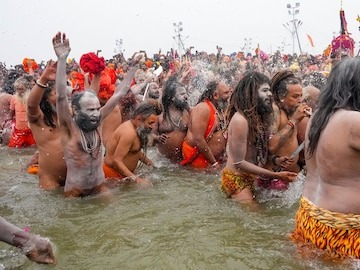
Maha Kumbh 2025 kumaon imbibed first Makar Sankranti on Tuesday initially bats Sadhus as Mahanirvani Panchavati Akhara performed Amrit Snan at triveni sangam the multicultural melting point of the rivers Ganga, Yamuna and Saraswati.
Found are 13 Akharas the warriors are organized in three broad groups namely- Sanyasi which Is Shaivite Bairagi which translates to Vaishnav and Udaseen.
Muharams Shaivite Akharas March 4, partly prepared Atal,Niranjani,Anand,Bhairav,Swahan,Agni, Nirmohi, նույնպես, Dhibambar ani, Nimrani ani, US (new and top), And One Nirmala Akhara.
Let’s analyze Akhadas, their structure, their historical aspects and their functional roles during the Kumbh Mela.
Akharas And Their Historica Importance
Within the Kumbh Mela, Akharas are responsible for several key events including the Amrit Snan. Akharas traditional roles are being preserved by the Akharas who were past guardians of temples and holy places.
Since the 8th century, Sadhus, or monks belonging to various Akharas, have made their way to Prayagraj for the purpose of Amrit Snan. Between the 9th and 18th centuries, the month-long Kumbh celebrations and the sequence of Amrit Snans were both put together by the Akharas. Now the sequence of Amrit Snans is much more structured than it was before; however, the Akharas are still in control of the situation.
Organizational Structure Of Akharas
Typically, a Mahant or Acharya, who has the duty of managing both the spiritual and administrative functions of the Akhara, being at the helm of affairs. Within an Akhara, other ranks and designations such as Mahamandaleshwar (senior and influential monks) are also stationed.
Such Akharas impart a comprehensive and robust curriculum with their training that emphasizes on spirituality, meditation, study of scriptures, and physical exertion such as Indian style wrestling and martial arts. These institutions demand discipline that ultimately result to mastery on both physical and mental aspects of the athlete that leads to spiritual secession.
Significance Of Akharas In Hinduism
Akharas are greatly revered in Hinduism for a myriad of reasons;
Conservation Of Culture: They are also important in the context of history because they help perpetuate old rites, traditions and religious teachings, and rituals. The flow of lore, hymns, scripture and other31 material practices is not interrupted from generation to generation.
Spiritual Training: Such institutions are also known as ashrams and these places promote an intense sanctified environment with the aim of developing selflessness, spirituality. The unique and disciplined way of life taken up by the members of these institutions is in order to achieve further spiritual growth.
Cultural Custodians: A great deal of activities including attending various cultural and religious festivals and going on a pilgrimage are all part of the wholistic approach of Akharas to cultural preservation and maintenance of Hindu society. Through participation in the Kumbh Mela, they fulfill their duty as cultural and religious figures.
Martial Heritage: Training in martial arts, that is, combative arts has always been the domain and province of the Akharas, which places their members in the ability to uphold the religion by guarding its religious sites. Some Akharas especially Naga Sadhus have a distinct martial tradition and that still remain within the Akhara structure.
Social Influence: Orphanages, hospices, schools, colleges, hospitals and other welfare establishments are run by the Akharas for charitable purposes and to influence society.
Important Akharas And Their Role In Maha Kumbh
Amrit Snan is performed by some contestants from 13 Akharas (Hindu monastic sects) who take bath in a specified order and at a predetermined time fixed system for the event. A great deal of effort is placed into organizing the process to make sure the administrative staff manages the timeline of the ceremony to allow the customs to be followed properly.
The table below summarizes some of the major Akharas and their significant functions in Maha Kumbha:
Juna Akhara: This is the biggest of the 13 Akharas. Juna Akhara belong to the Dashnaami Sampraday of Shaivism established by Adi Shankaracharya, and they offer prayer to Lord Dattatreya. The Kinnar Akhara which is the Transgender Akhara is also under the Juna Akhada. The members of Juna Akhara are mainly Shaiva, worshippers of Lord Shiva, and many of them belong to naga order. The role of Juna Akhara in Kumbh Mela cannot be overstated, given that its sadhus or holy men are recognized for their self-discipline and asceticism. The akhara has a strong tradition in spiritual and martial arts as it prepares and equips its members to defend the faith and adhere to the tenets of Sanatan Dharma. The current leader of the Akhada is Acharya Mahamandaleshwar Swami Avdheshanand.
Niranjani Akhara: Shri Panchayati Niranjani Akhada which was founded in the year 904 A.D in Gujarat, is registered as the Second. Both citizens and foreigners are devotees of this institution, where mainly the members worship Kartikeya. Many of its members are well educated, having earned PhD and post graduate degrees which indicates the members’ concern for academics as well as spirituality. The current leader of the Akhada is Acharya Mahamandaleshwar Kailashanandji Maharaj.
Mahanirvani Akhara (Prayagraj): Shri Panchayati Mahanirvani Akhada hails sage kapil as the deity who posses all the wisdom that one seeks, he is also accompanied with several symbols that his devotees associate with such as Bhairva Prakash Bhala and Surya Prakash Bhala that bestow them with protection and knowledge, the teertha provided by this akhara is deeply rooted to its rich spiritual and symbolic practices that have expanded its popularity amongst the religious community at large, its chief is Acharya Mahamandaleshwar Swami Vishokananda.
Kinnar Akhara: Akhara Kinnar is also known as the transgender akhara transgender people are inclusive within the culture and community and are allowed to take part in the sacred practices which include gathering for the holy pilgrimage of kumbh melawhere as the rest of the akharas tend to be predominantly male class, Akhara Kinnar strives to provide a firm standing ground where transgender people can showcase their spiritual devotion and passion. Kinnar Akhara indulges into spiritual offerings such rituals, prayers and meditation as a means to meet their guardians, Furthermore, the Akhara is involved into the Kumbh Mela procession alongside the other Akharas that symbolises the integration of transgender people into the Hindu society. The existence of Kinnar Akhara in the context of Hinduism serves to demonstrate that spirituality does not discriminate against or exclude any individual regardless of background.
How Shahi Snan Got Renamed To Amrit Snan
Further commenting on the use of the name Amrit Snan rather than Shahi Snan, Uttar Pradesh Chief Minister Yogi Adityanath has argued that the Indian customs and traditions are getting lost and thus we need to restore the true essence of these names by far amending them meaning the need as to how these terms were coined was in good faith and should be respected.
To put more context, Mahant Ravindra Puri, who is the president of the Akhil Bharatiya Akhara Parishad (which is India's oldest and contemporary Hindu organization) told PTI, that inclusive terms such as ‘shahi snan’ as well as ‘peshwai’ which were used for the Kumbh Mela have now been replaced by Amrit Snan and Chhavni Pravesh to cover a widen audience.
"In Hindi and Urdu we all speak words. For us, it is not a possibility that there is a word of Urdu that we refuse to use," said Mahant Puri, who heads the Mansa Devi Temple Trust in Haridwar, “But we thought that when it comes to our Gods, we should make efforts to have a name in Sanskrit language or have a ‘Sanatani’ name. The idea is not to make it Hindus and Muslims," he explained.
In the year 1761 during the Haridwar Kumbh there was a bloody conflict between the Akharas of the Shaiva sect and the Akharas of the Vaishnav on who would be the first to take a dip in the holy water. There were heavy casualties on both ends.
As per the statement given by historian and professor Heramb Chaturvedi, ”Baba Ramchandra Das of Chitrakoot filed an application during the Nashik Kumbh that the fighting should stop. The Sattari fought over the petition when it reached Peshwa court.” Deviating away in a conversation with news18, Chaturvedi said while recalling the proceedings of the Peshwa he said that during that time the Peshwa of mahajans equity view of sena batra was that the Mahamandaleshwars decided tthat nashik would be the first broth in one kumbh and would be followed byuras,” ” In 1801 this was achieved with the Peshwise Shahi snan and the Maha snan became sone to enter during Kumbh Mela in 2001:]. Baba Ramchandra remembered the Peshwa liked initiating such cycles in the Akharas as well.” So Baba Ramkcandra made him the leader, and so instead of seating one person until divided them into groups, they would italians take turns so one group could reach the boiling point while the other set could hhewrest one fish, they would simply roll between the cycles which ensured that there was no contact.”
The Akara Parishad also aided in the mitigation of such fights. The Akharas set coordinates for their movement to this day. During the periodic competitions these were suppor the managers. Disputes between the akharas are common and rather an expected thing. Although Mara and Mathur sit together and have meetings, but I don’t think they ever come to an agreement.
The leader of the Akhara’s charioteers, which is the revered Acharya Mahamandaleshwar, is always at the front of the group headed for the bath. After him, in an orderly manner according to rank and position, comes Mahamanthra (a title accredited to Hindu monks of the Dashanami order), Shri Mahant and a group of Mahants, Kumath and Thanapati and other officials of the Akharas. The authorities make arrangements for the details of the specific route for this procession. The devotees are positioned along the barricades on both sides and they smear the dust of the saints’ feet on their foreheads.
Five ‘Amrit Snans’ will take place — January 14, Makar Sankranti; January 29, Mauni Amavashya; February 3, Basant Panchmi; February 12, Maghi Purnima, and the last one is expected to take place on February 26, Maha shivratri.

 Desk
Desk Share
Share

_939839210.jpg)




